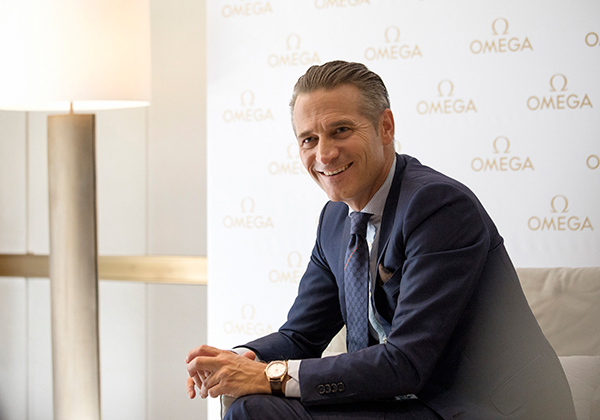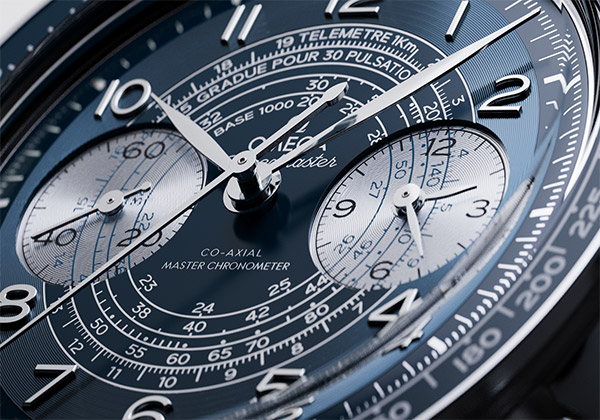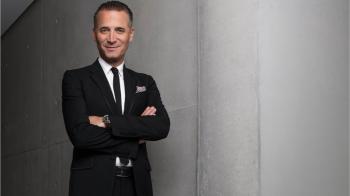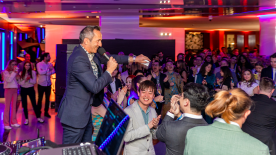The recent launch of the Omega Speedmaster Chronoscope in Milan gave us the rare opportunity to sit down with brand CEO and one of watchmaking’s most dynamic personalities, Raynald Aeschlimann, to find out the answers to some of the burning questions we’ve had in mind. Despite the turbulence of the last two years, Omega has had an outstanding balance sheet, and its leadership is a clear factor in its success. Here is a condensed and edited account of what was shared with us in Milan.
Tell us why you decided to launch the Omega Speedmaster Chronoscope here in Milan; is there a special connection between the watch and the city?
There were many, many reasons. For us, it was also very interesting to make it a moment where you get the vibration coming from Milan Fashion Week (happening at the same time). We could have done this at Omega headquarters in Bienne, as we've done a lot, and that would also have been nice. On the other hand, we wanted to bring some of our friends together in a place where there's a special feeling for the Speedmaster, for chronographs. And Italy definitely has this feeling, not just for watches, but for the Speedmaster in particular. We also wanted to tell a different story from what we've been doing with the Moonwatch — we've done a lot around this over the last two to three years, because there were certain historical milestones that were important to celebrate. And we wanted to make the distinction between that and what we want to do with the Chronoscope. So we chose to do this in Milan for these special reasons.

Tell us a little more about this distinction between the Moonwatch narrative and what you'd like to achieve with the Chronoscope.
I want to take you a step back to think about all the development we did over the last few years, with more than 40 in-house calibres now having our Master Chronometer certification. These new developments take a lot of time, and when you plan like that over the long-term, in our minds we have always been clear about what product belongs where. When we released the calibre 3861, we knew what we wanted to do with it, knowing its capability. It was a celebration of the Speedmaster in a way. Looking back at the historic placement of the Chronoscope in the DeVille collection, it's also very clear to us now that the strength of our chronograph expertise works best in the Speedmaster family, one of the most iconic chronograph families of all time. In terms of reorganisation of our product lines, but also in order to tell the strongest chronograph stories we can, I know this is where the Chronoscope belongs. It's a Speedmaster, yes, but positioned in a new way; the design tells a different story from the Moonwatch.

So we should understand that a Speedmaster is and always will be a chronograph.
Yes. For me, there is no discussion about this. At Omega, we're privileged to have these collections that have so much history, and I think it's important to keep to the core DNA as much as possible. There are lots of knowledgeable people, Speedmaster experts, who can bring up historical examples of when we did different things here and there, but where I'm standing, I look forward and I can tell you that I see the Speedmaster as a chronograph, and it'll remain this way. We're lucky to have this collection, and lucky that people are so familiar with the story, to the level that if you think about this black dial, about this style of tachymeter, these lugs, even chronographs in general — people think immediately of the Speedmaster.
We seem to be getting more or less back to a normal kind of life now — how is Omega doing in that regard?
What's very interesting during this this time is that, first of all, we always have to think about being a global company. We have 155 points of sales today all over the world, and some of them are still closed today. The whole situation made us highly aware of that — you all know us, we are all about our people. We have affiliates in many, many countries; we have people that are working for us everywhere, not just in stores but in offices too. How do you keep things going? That was a big challenge for us. On the other side, being a very universal brand, we were fortunate that we could always have something happening somewhere. You know, we launched the Speedmaster Silver Snoopy during the pandemic. We launched the new Moonwatch 3861 during this time too. That means that on an operational basis, it was an enormous logistical and organisational effort to look after our people, to see if we could deliver what we launched, to remain as close to our customers as possible. But that's what we wanted, you know, we wanted to remain present. On a normative level, your vision doesn't change. You can't suddenly become an agile and dynamic brand if you were not doing that stuff before. It's always been in our blood — making things happen despite closures, delivering when it looked impossible. This was only possible because of our customers, not just because there is a demand for our watches, but more because of the emotion behind that demand. You see now that some of our busiest markets are the biggest countries in the world, dealing with local customers. China is doing fantastically — we are leaders in this market. We're growing a lot in the US. We're back on track, which is so important to me, and it's because of how Omega has always been as a company.

Obviously during the height of the pandemic, a lot of us had to adapt. We took on different strategies, different directions for the short term. Now that things seem to be returning to normal, is there anything from that time you'd choose to keep? For example, an emergency short-term strategy that ended up proving its reliability and long-term worth?
Perhaps it's still too soon to say for sure, but something very important for us during that time was that we were one of the first companies to open mono-brand e-commerce activities in the States. I'm not talking about opening up an online point of sales within three months just because of Covid, but for instance our e-commerce platform in the US, which is far and away our best-performing store over there, selling better than Fifth Avenue and all that. We opened it three years ago, and most importantly, we opened it the way I wanted it. It's not just another site to sell watches — it delivers the whole Omega experience, the same experience you have in a physical store. And when Covid hit, I knew that was the point at which we could accelerate this side of things. We could only do it because we already had a good base. We didn't open up online sales just because of Covid. And that's why we will never have people saying that we only went digital because of the pandemic. Working on a universal approach has always been the way for me, even back in the era of Mr Hayek Sr., when I was in charge of India for the entire group. Building the network there was important. And we see that now, when things are starting to happen again over there, we're one of the first brands to start delivering again to stores that are just beginning to reopen. Because we already had that infrastructure. Another priority that has been reinforced for us during the pandemic is being close to our customers. That's something we've always done and we're not going to change. People asked, why are you making so many key launches during the pandemic? I said, why not? Why change our vision? This is the time to get even closer to people who love Omega. The success you have on a global level is the result of the work you do on a local level. Tourist business is great, but you have to do the job at home with local clients too, otherwise you'll be stuck waiting for people who won't or can't come to you.

Speaking of client relationships, we recently learned that you're done with limited editions. No more limited editions from Omega — 10,000 pieces of this or 5,000 pieces of that.
I want to clarify what I mean by being done with limited editions. It's not that we're done with them forever or done with them completely. As the brand progresses, it's important to keep looking at our strategy and asking ourselves if they still make sense for us. Limited editions were always linked with the Speedmaster, especially in the mind of the customer. Now that we have re-established the pillars of Omega timepieces and made them very clear, it's important to me that any new introductions to the collections, whether it's a new design or a new look or a special dial, they need to be implemented over the long term. They can't just be here for a while and then go away, which is what a limited edition is. I repeat — it has to be long term. Before, limited editions were a way to bring a strong focus of attention on a particular collection, because people are naturally attracted to something like that, with the word "special" or "limited" attached to it. We've decided that this time is over for us. What we're going to do is what we did with the Silver Snoopy — we worked so hard on this piece and we never thought about limiting it to attract more attention. At the same time, we've reduced the product offering in general, so the pieces that remain can have a much longer life. It's definitely a strategic decision for us. And here's something to reaffirm this — the James Bond watch. If it had been a limited edition back when we launched last year according to the original movie premiere, I wouldn't be able to do anything for everyone now who wants the watch now that the movie is finally out. It would have been such a pity if it had been a limited edition. It's not luck that we're still able to produce and sell such a specific watch, linked with a specific movie, over 18 months. This is our strategy. Of course, we will still have special collections, because of partnerships like the Olympic Games. But limitations? No, that's over.






